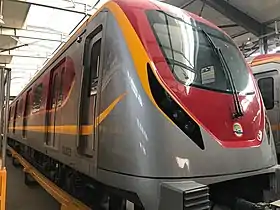| Lahore Metro | |||
|---|---|---|---|
 | |||
 Train of the Orange Line at a station. | |||
| Overview | |||
| Owner | Government of Punjab | ||
| Locale | Lahore, Punjab, Pakistan | ||
| Transit type | Rapid transit | ||
| Number of lines | 1 completed (2 planned) | ||
| Number of stations | 26 | ||
| Annual ridership | 20 million (2020-2021)[1] | ||
| Operation | |||
| Began operation | 25 October 2020 | ||
| Operator(s) | Punjab Mass Transit Authority, Guangzhou Metro | ||
| Technical | |||
| System length | 27.1 km (16.8 mi) | ||
| Track gauge | 1,435 mm (4 ft 8+1⁄2 in) standard gauge | ||
| |||
Lahore Metro is an automated rapid transit system in Lahore, Punjab, Pakistan and the first driverless metro in Pakistan. Three metro lines have been proposed, of which the Orange Line is operational. It is also Pakistan's first metro line system.
History
The Lahore Metro was first proposed in 1991 and reviewed in 1993 by the Lahore Traffic & Transport Studies, funded by the World Bank. The project was subsequently shelved.[2] In 2005, the Ministry of Transport revisited the project and carried out a feasibility study. In 2007, the Asian Development Bank provided Rs. 1 billion (US$3.5 million) to conduct a study on the project.[3] The initial plan called for an 82 km (51 mi) rail network with 60 stations to be constructed in four separate phases. The first phase involved the construction of a 27 km (17 mi) rail line between Gajju Matta and Shahdara Bagh, with an 11.6 km (7.2 mi) section underground. Construction was expected to start in 2008 and be completed by 2010.[3] However, in 2008, the project was shelved again as priorities shifted to other projects.[4]
In June 2010, Malaysia-based Scomi International proposed a US$1.15 billion monorail alternative, but that was not approved.[3] At a ceremony in May 2014, an agreement was signed by Chief Minister Punjab Shahbaz Sharif, alongside President Mamnoon Hussain and Chinese Communist Party general secretary Xi Jinping, which gave the go-ahead for the construction of the Orange Line. The project was estimated to cost $1.6 billion.[5]
Lines
Orange Line
The Orange Line has a length of 27.1 kilometres (16.8 mi) and became operational on 25 October 2020.[6]
Blue Line
The Blue Line is a proposed 24-kilometre (15 mi) line from Chauburji to College Road, Township.
Purple Line
The Purple Line is a proposed 32-kilometre (20 mi) airport rail link.
Network map
Stations
The line has 26 stations. Anarkali and Central stations are underground, while the remaining 24 are elevated.[7] The rail line runs through the centre of each station, with platforms flanking the track.[8] Elevated stations have a width of 22.5 metres, while Anarkali Station is 16 metres wide, and Central Station 49.5 metres wide.[9] Elevated stations are all 102 metres long, while Anarkali and Central Stations are 121.5 and 161.6 metres long, respectively.[10]
Anarkali and Central Stations were initially planned to have two underground levels,[11] Anarkali Station now both feature a ground-level concourse with one underground level, while Central Station has a single underground level, in order reduce the maximum gradient for trains from 35% to 30%.[12] Rail tracks are 9.7m below street level at Central Station, and 8.7m below street level at Anarkali Station.[13]
Underground stations feature automated doors between platforms and trains. Public areas of the station are air-conditioned during warm months.[14] Elevated stations feature natural ventilation throughout the platforms, with localised air conditioning in public areas of the ticket-hall level.[15]
Rolling stock
Orange Line trains are each composed of five wagons manufactured by China's CRRC Zhuzhou Locomotive,[16] and automated and driverless.[17] A standard Chinese "Type B" train-set consisting of 5 cars with 4 doors each used,[18] that has a stainless steel body and illuminated by LED lighting.[19] Each car has a nominal capacity of 200 seated and standing passengers at an average density of 5 persons per square metre with 20% of passengers seated and 80% standing.[20] A total of 27 trains with 135 cars have been ordered for the system,[21] at a cost of $1 billion.[22] A total of 54 trains are expected to be in service by 2025.[22] The train is powered by a 750-volt third rail.[23][22]
Track

The Orange Line's tracks meet China's national standards,[24] and employ jointless track circuits.[25] Mainline track is capable of supporting 60 kg/m, while track in the depot and storage yards is capable of supporting 50 kg/m.[26] Track was laid upon a monolithic concrete track bed, with crossovers located between every 2 to 3 stations.[27] Double turnover tracks are used at each terminus for turnaround.[28] Track is standard gauge at 1435mm.[29] Fasteners between tracks are elastic.[30]
Depot
A depot was constructed at the northeast portion of the line, directly east of the Lahore Ring Road,[31] while a stabling yard was constructed at the line's southern terminus at Ali Town.[32] The depot is also the site of the Orange Line's central control centre.[33] The depot and stabling yard respectively required 0.56 and 0.49 kilometres of track.[34]
See also
References
- ↑ "Orange Line Metro Train marks its 1st anniversary with a milestone of 20 million riders". Daily Pakistan. Retrieved 2022-01-26.
- ↑ Asian Development Bank 2008, p. 2.
- 1 2 3 The Express Tribune 2011.
- ↑ Asian Development Bank 2009.
- ↑ Daily Times 2011.
- ↑ "Punjab CM inaugurates Lahore's much-delayed Orange Line Metro Train". Daily Pakistan. 25 Oct 2020. Retrieved 2020-10-25.
- ↑ "Good news on track: Lahore to get Pakistan’s first metro train", Express Tribune, Lahore, 23 Mar 2014. Retrieved on 20 October 2014.
- ↑ "Norinco Technical Proposal" (PDF). January 2016. p. 12. Archived from the original (PDF) on February 2, 2017. Retrieved 25 January 2017.
- ↑ "SECTION - 3 DESCRIPTION OF THE PROJECT" (PDF). EIA of Construction of Lahore Orange Line Metro Train Project (Ali Town –Dera Gujran). Environmental Protection Department. Retrieved 25 January 2017.
- ↑ "SECTION - 3 DESCRIPTION OF THE PROJECT" (PDF). EIA of Construction of Lahore Orange Line Metro Train Project (Ali Town –Dera Gujran). Environmental Protection Department. Retrieved 25 January 2017.
- ↑ "Norinco Technical Proposal" (PDF). January 2016. p. 7. Archived from the original (PDF) on February 2, 2017. Retrieved 25 January 2017.
- ↑ "Norinco Technical Proposal" (PDF). January 2016. p. 9. Archived from the original (PDF) on February 2, 2017. Retrieved 25 January 2017.
- ↑ "Norinco Technical Proposal" (PDF). January 2016. p. 69. Archived from the original (PDF) on February 2, 2017. Retrieved 25 January 2017.
- ↑ "SECTION - 3 DESCRIPTION OF THE PROJECT" (PDF). EIA of Construction of Lahore Orange Line Metro Train Project (Ali Town –Dera Gujran). Environmental Protection Department. pp. 3–10. Retrieved 25 January 2017.
- ↑ "SECTION - 3 DESCRIPTION OF THE PROJECT" (PDF). EIA of Construction of Lahore Orange Line Metro Train Project (Ali Town –Dera Gujran). Environmental Protection Department. pp. 3–10. Retrieved 25 January 2017.
- ↑ "Short Cuts". The Ec was onomist. 17 March 2016. Retrieved 24 January 2017.
- ↑ "Manufacturing of orange trains starts, says Kh Hassan". The News. 26 May 2016. Retrieved 24 January 2017.
Latest technology will be employed for fabricating these trains and the rolling-stock will be fully computerised, automatic and driverless.
- ↑ "SECTION - 3 DESCRIPTION OF THE PROJECT" (PDF). EIA of Construction of Lahore Orange Line Metro Train Project (Ali Town –Dera Gujran). Environmental Protection Department. Retrieved 25 January 2017.
- ↑ "Norinco Technical Proposal" (PDF). January 2016. p. 36. Archived from the original (PDF) on February 2, 2017. Retrieved 25 January 2017.
- ↑ "Norinco Technical Proposal" (PDF). January 2016. p. 35. Archived from the original (PDF) on February 2, 2017. Retrieved 25 January 2017.
- ↑ "Manufacturing of orange trains starts, says Kh Hassan". The News. 26 May 2016. Retrieved 24 January 2017.
- 1 2 3 "27 trains to be acquired for Metro project". Pakistan Today. 5 February 2016. Retrieved 24 January 2017.
- ↑ "Orange train to run on 750 volts". Dawn. 18 January 2016. Retrieved 25 January 2017.
- ↑ "SECTION - 3 DESCRIPTION OF THE PROJECT" (PDF). EIA of Construction of Lahore Orange Line Metro Train Project (Ali Town –Dera Gujran). Environmental Protection Department. Retrieved 25 January 2017.
- ↑ "Norinco Technical Proposal" (PDF). January 2016. p. 143. Archived from the original (PDF) on February 2, 2017. Retrieved 25 January 2017.
- ↑ "SECTION - 3 DESCRIPTION OF THE PROJECT" (PDF). EIA of Construction of Lahore Orange Line Metro Train Project (Ali Town –Dera Gujran). Environmental Protection Department. Retrieved 25 January 2017.
- ↑ "Norinco Technical Proposal" (PDF). January 2016. p. 27. Archived from the original (PDF) on February 2, 2017. Retrieved 25 January 2017.
- ↑ "Norinco Technical Proposal" (PDF). January 2016. p. 28. Archived from the original (PDF) on February 2, 2017. Retrieved 25 January 2017.
- ↑ "Norinco Technical Proposal" (PDF). January 2016. p. 33. Archived from the original (PDF) on February 2, 2017. Retrieved 25 January 2017.
- ↑ "SECTION - 3 DESCRIPTION OF THE PROJECT" (PDF). EIA of Construction of Lahore Orange Line Metro Train Project (Ali Town –Dera Gujran). Environmental Protection Department. Retrieved 25 January 2017.
- ↑ "Norinco Technical Proposal" (PDF). January 2016. Archived from the original (PDF) on February 2, 2017. Retrieved 25 January 2017.
- ↑ "Norinco Technical Proposal" (PDF). January 2016. Archived from the original (PDF) on February 2, 2017. Retrieved 25 January 2017.
- ↑ "Norinco Technical Proposal" (PDF). January 2016. Archived from the original (PDF) on February 2, 2017. Retrieved 25 January 2017.
- ↑ "Norinco Technical Proposal" (PDF). January 2016. p. 12. Archived from the original (PDF) on February 2, 2017. Retrieved 25 January 2017.
- "Proposed Technical Assistance Loan" (PDF), Asian Development Bank Projects, Asian Development Bank, retrieved 18 January 2013
- "Lapse of Validity of Loan Approval" (PDF), Asian Development Bank Documents, Asian Development Bank, retrieved 18 January 2013
- Punjab project: Lahore rapid transit scheme being revived, The Express Tribune, retrieved 18 January 2013
- LRMT fares for 2011, Daily Times, retrieved 18 January 2013
- Morichi, Shigeru (2013), Transport Development in Asian Megacities, Springer, ISBN 978-3-642-29743-4
Further reading
- Mughal, Owais (2007-08-20). "Lahore Rapid Mass Transit Rail Project". All Things Pakistan.
- "Lahore mass transit system". DAWN. Pakistan. 2007-07-12.
